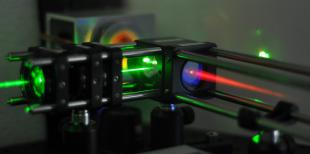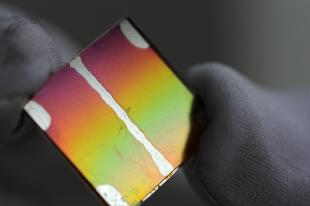Chiral nematic liquid crystals self-organise themselves at a molecular level into helical organic nanostructures. Through the phenomenon of Bragg reflection, the periodic nature of these nanostructures gives rise to a one-dimensional photonic band-gap, which selectively reflects a narrow band of electromagnetic radiation. By controling the degree of chirality within the system, we can tune the reflection colour. Furthermore, by adding organic fluorescent laser dyes into the chiral nematic liquid crystal, we can achieve optical gain in the presence of a self-assembled distributed feedback resonant cavity. When such a system is excited by a pulsed optical pump, we can achieve photonic band-edge lasing.
In this research project, we seek to investigate and optimise the parameters required for liquid crystal lasing, and to develop new improved systems for specific applications. Such systems will capitalise on the unique properties of liquid crystal lasers:
- Broad wavelength tuning (450-850 nm)
- Low-cost fabrication
- Compact architecture (suitable for portable applications)
- Multiple simultaneous (or time-sequential) emission wavelengths
- Disposable laser cartridges
- High slope efficiencies (~60%)
Initial targets for liquid crystal laser applications include fluorescence microscopy, confocal microscopy, fluorescence lifetime imaging (FLIM) and flow cytometry. Liquid crystal lasers offer significant improvements in such techniques, including: accessing of optimal probe wavelengths; increased parallelism; reduced cost; and portable (including on-chip) applications.
Commercial and industrial enquiries regarding opportunities for co-development of systems utilising liquid crystal laser technology are particularly welcome. Further information can be found in the document below, or by emailing the research lead, Dr Philip Hands.
Principal Investigator:
Postgraduate Researchers:
Margaret Normand
PhD research student (CDT in Intelligent Sensing & Measurement)
Applications for PhD or MSc study welcome from excellent graduates with a background in Physics, Engineering, Photonics, Materials.




